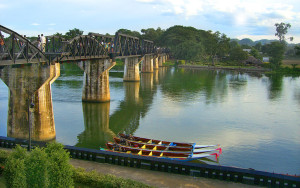One of Thailand’s most vivid remnants of World War II is the Death Railway – originally a 415 km stretch of train track between Ban
Pong in Thailand and Thanbyuzayat in the now-Myanmar, built on the command of Japan using forced labour from the Asian Romusha and Allied prisoners of war (POWs).
Over 180,000 Romusha – Asian civilian labourers – and 60,000 POWs worked on the railway, with over 100,000 workers dying there as a result of their efforts.
Built in 1943, Japan designed the line in order to support their war efforts in the Burma (now Myanmar) war campaign. Many Japanese military officials involved in the Death Railway were tried and sentenced to death for war crimes as a result of it.
The line closed after the conclusion of the war in 1947, although the section between Nam Tok and Nong Pla Duk was reopened in 1957.
The Death Railway has been immortalised in film with The Bridge on the River Kwai, The Railway Man and in literature, with the Richard Flanagan book, The Narrow Road To The Deep North.
Thailand is currently working to revitalise the remaining line, between Ratchaburi and Kanchanaburi provinces, with the State Railway of Thailand vowing to complete maintenance this June, according to the Bangkok Post.
The track stretches from Nam Tok station in Kanchanaburi down to Nong Pladuk junction in Ratchaburi and is 126 km long. It’s particularly popular with tourists wanting to find out more about its bloody history.
Maintenance so far has included replacing worn tracks and sleepers, installing heavier rails and bigger switches, strengthening track foundations, and strengthening the famous wooden Tham Krasae Bridge. The final thing to be installed are new railroad switches in Kanchanaburi, scheduled to finish on 17 June 2016.
As well as making for greater safety on the line, the improvements should mean faster and smoother travel, from a current speed of 40 km/hour all the way to 90 km/hour.
Source: http://whatsonsukhumvit.com/death-railway-restoration-to-complete-in-june/




